Before we show you Scott’s solution, let’s remind ourselves of the challenge he was posed.
It is time for the MLS All-Star match and you have been selected to coach Team MLS as they face Ole Gunnar Solskjaer’s Manchester United during the Red Devils’ pre-season tour.
— Total Football Analysis (@TotalAnalysis) April 21, 2020
Here’s the tactic wars dilemma…it is time for the MLS All-Star match and I have been selected to coach team MLS as we face Ole Gunnar Solskjaer’s Manchester United during the Red Devils’ pre-season tour. MLS and I want to make a statement by beating English Premier League side as we’re are sick of people overlooking the MLS as a competitive league.
This year I am picking a team to win, and I’m not planning on rotating my whole squad at half time. I am picking a starting eleven to beat Manchester United.
Of course, picking the best starting eleven is one thing, but considering the talent available to the Norwegian boss, my tactics are going to be the deciding factor in this one.
Manchester United, likely playing in their 4-4-2 diamond, have a fully fit roster to pick from and haven’t made any transfers during the summer window. A tactical analysis of Solskjaer’s side has guided my roster decisions.
Lineups
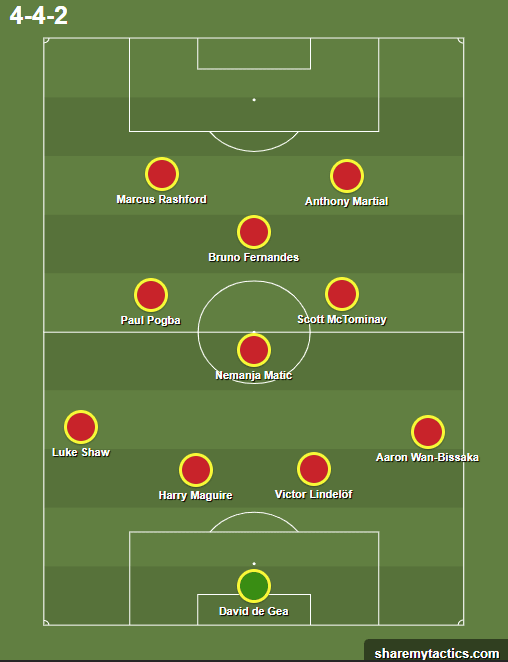
Manchester United (4-4-2): David de Gea; Aaron Wan-Bissaka, Victor Lindelöf, Harry Maguire, Luke Shaw; Nemanja Matic, Scott McTominay, Paul Pogba, Bruno Fernandes; Anthony Martial, Marcus Rashford.
With the delay in the EPL and MLS seasons, the MLS All-Star game has given Manchester United time to heal from some prominent injuries. Solskjær’s side sees Pogba and Rashford return to the starting lineup, making my job more difficult. I expect McTominay to play more defensively as the right-sided box-to-box midfielder, allowing Pogba to play higher up the pitch. He’ll combine with Fernandes, the forwards and Shaw while McTominay and Matic offer coverage against the counterattack. Even with Pogba playing higher up the pitch, Fernandes will offer a key outlet for United, so my side will have to deny him time and space on the ball while also protecting ourselves against the pace of Rashford and Martial.
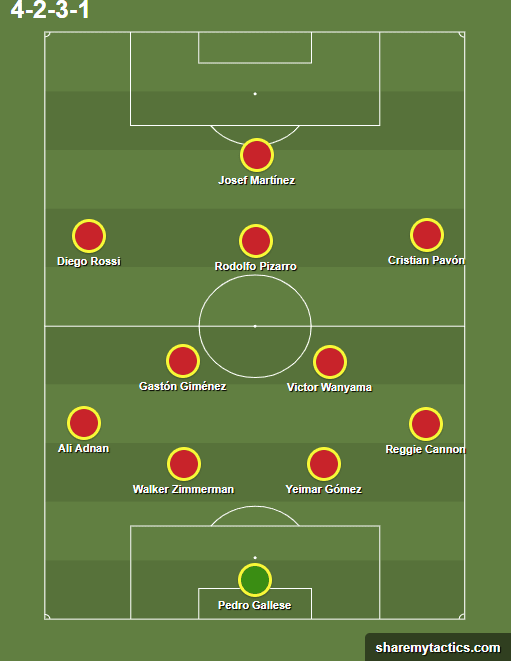
My MLS All-Stars (4-2-3-1): Pedro Gallese; Reggie Cannon, Yeimar Gómez, Walker Zimmerman, Ali Adnan; Gastón Giménez, Victor Wanyama; Cristian Pavón, Rodolfo Pizarro, Diego Rossi; Josef Martínez.
Our singular goal is defeating Manchester United in the All-Star game. When compiling my roster, I went a step further. First, all of my players are under the age of 30 (sorry Carlos Vela and Chicharito). A benefit of the delayed match is the Martínez has fully recovered from his injury and starts up top. Since United is in preseason form, I want young players who can push the tempo of the match, forcing United to play a little quicker than they’re comfortable with at this time. An additional advantage of this lineup is that each player is either in their prime or a top young talent hungry for that big European move. The one exception is Wanyama, who will surely look to prove that he was robbed of playing time at Tottenham. His experience and knowledge of this United side will greatly benefit my young squad. Only Gómez lacks international caps, so this is a side with a wealth of experience at the international level.
In terms of our formation, this assemblage of players come from all over MLS. The lack of chemistry is always a big issue in All-Star teams, so tactical clarity is essential. A common system with highly defined roles offers us the greatest chance of success. Since we’re assuming Man U will play a 4-4-2 with a diamond midfield in this game, I’ve opted for a 4-2-3-1. That gives us numerical superiority deep in our central channel with the two holding mids able to drop in and support the centre-backs while denying Fernandes time to utilize his world-class play-making ability. Plus, those two wide-attacking mids are willing to back-track and put in a tackle while also possessing the pace and individual ability to counterattack.
Defensive structure
Watching United play this season, they tend to occupy the central channel and half-spaces with the majority of the side, allowing the outside-backs to roam the wings. That works for me. We’re going to deny central penetration and concede the wings to United. We will always defend in just three of the five vertical channels. Defensively, we benefit by congesting passing lanes and offering coverage against the superior individual quality of the United players. In that transitional moment to attack, we’ll also have numbers around the ball for quick ball circulation with high outlets.
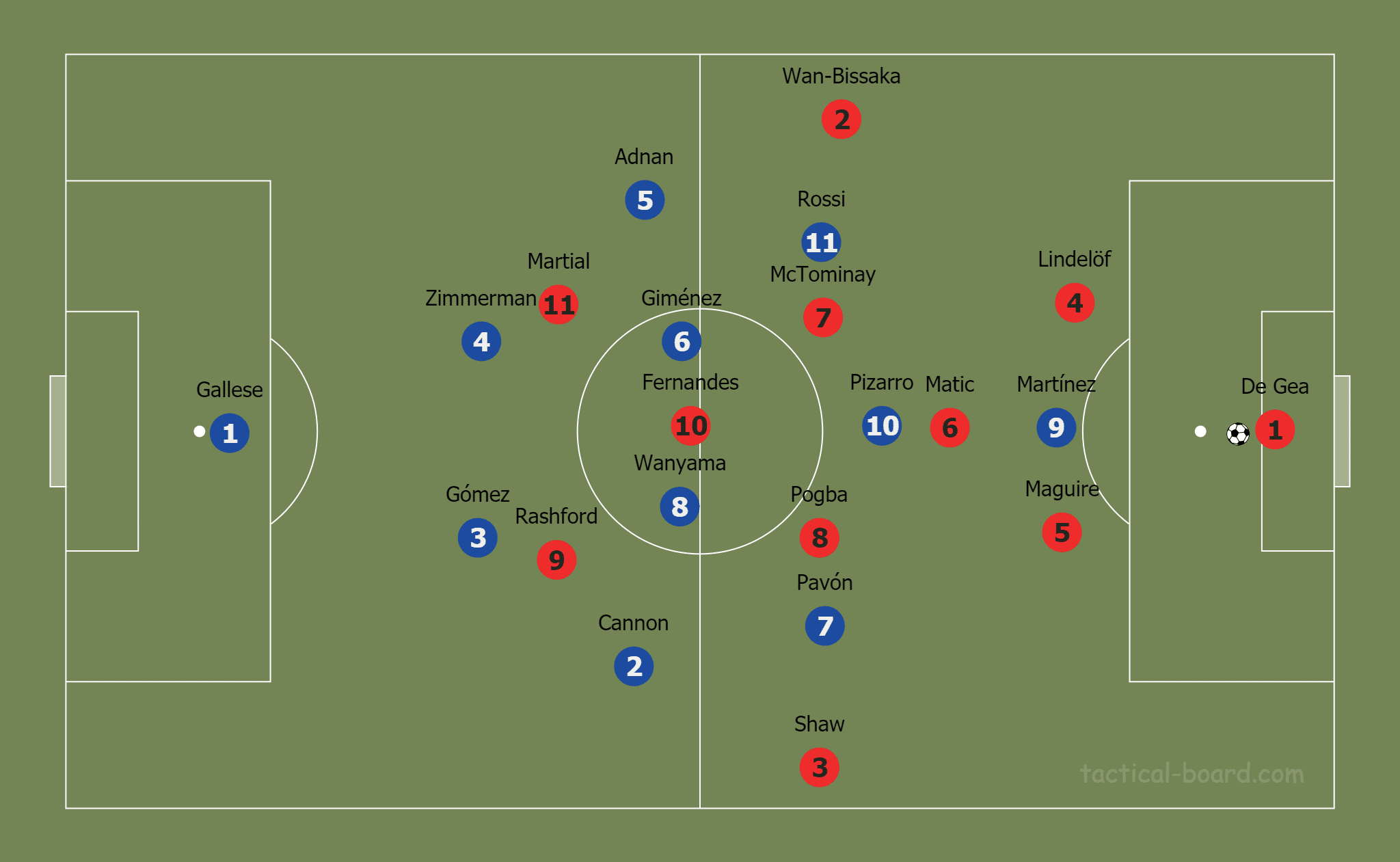
As United build out from De Gea, taking away access to the midfield diamond is critical. We’ll ask Martínez to position himself between one of the two centre-backs. De Gea will either play into one of them or skip his deepest players to play Shaw or Wan-Bissaka.
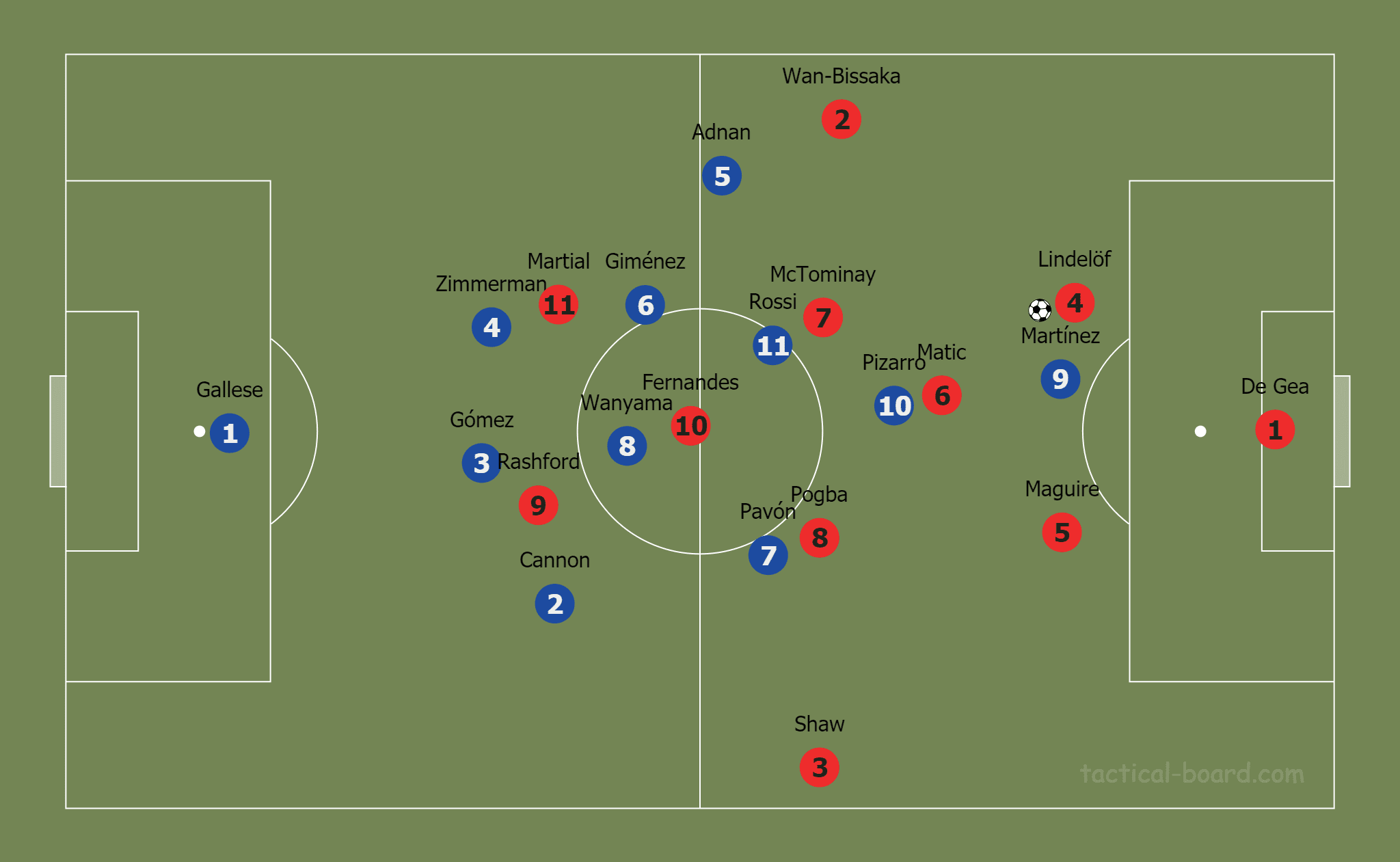
If he passes to a centre-back, Martínez will close him down while denying a direct passing lane to the other 4/5, in this case, Maguire. If the pass goes into Matic, Pizarro must try to force him to play to Wan-Bissaka. We don’t want the ball heading to Maguire, who would then play Shaw. We’re fine if that happens, but our best-case scenario is pinning them in on the same side where they’ve initiated the attack.
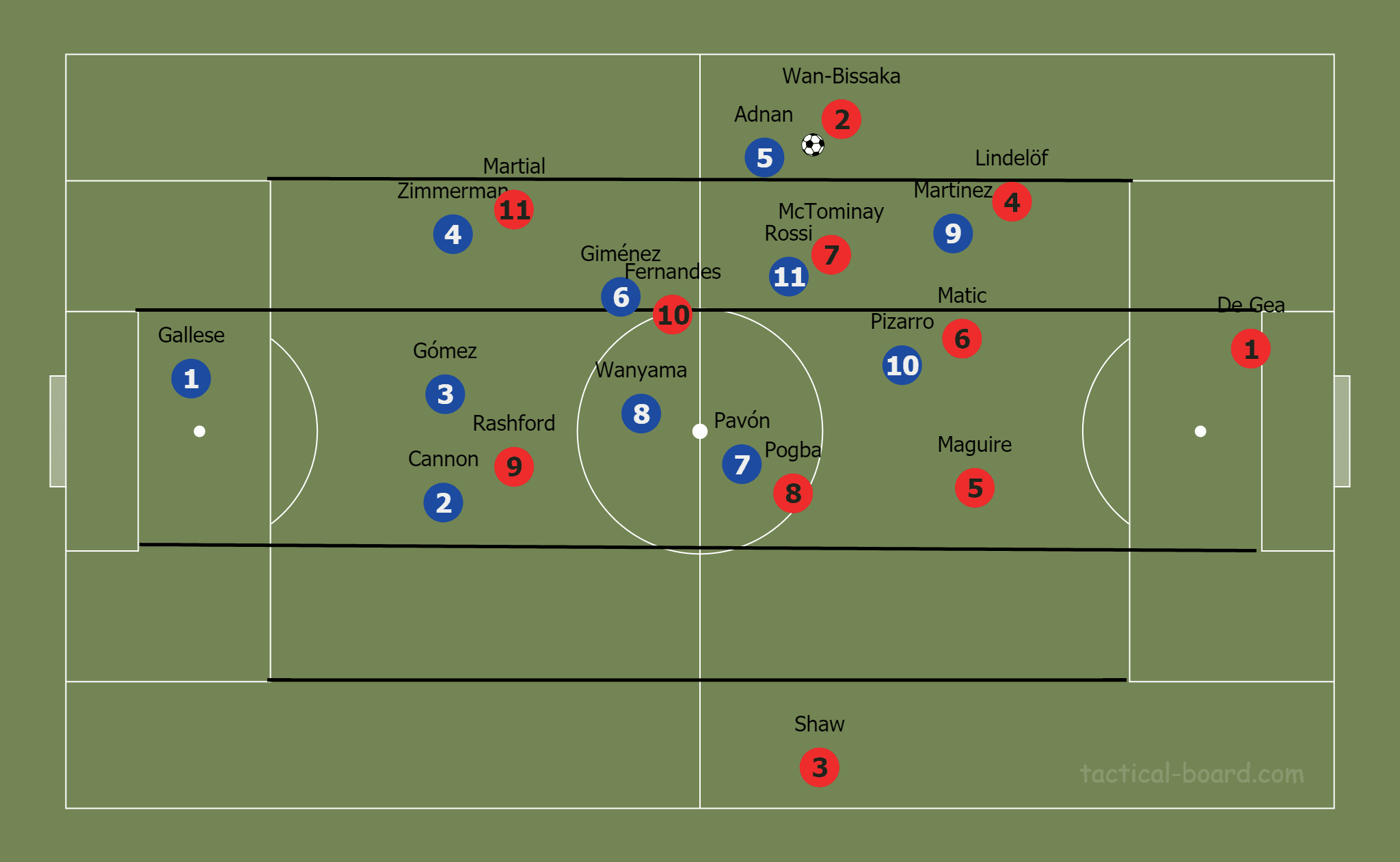
As the ball moves wide to outside-backs, we immediately shift our defence to eliminate the short and intermediate options while maintaining a numerical superiority at the back. Now that we’ve pinned them on the wings, we want to aggressively press their attack knowing that we have a numerical advantage to negate their quality. This may be a friendly, but you wouldn’t know that by our pressing and tackling.
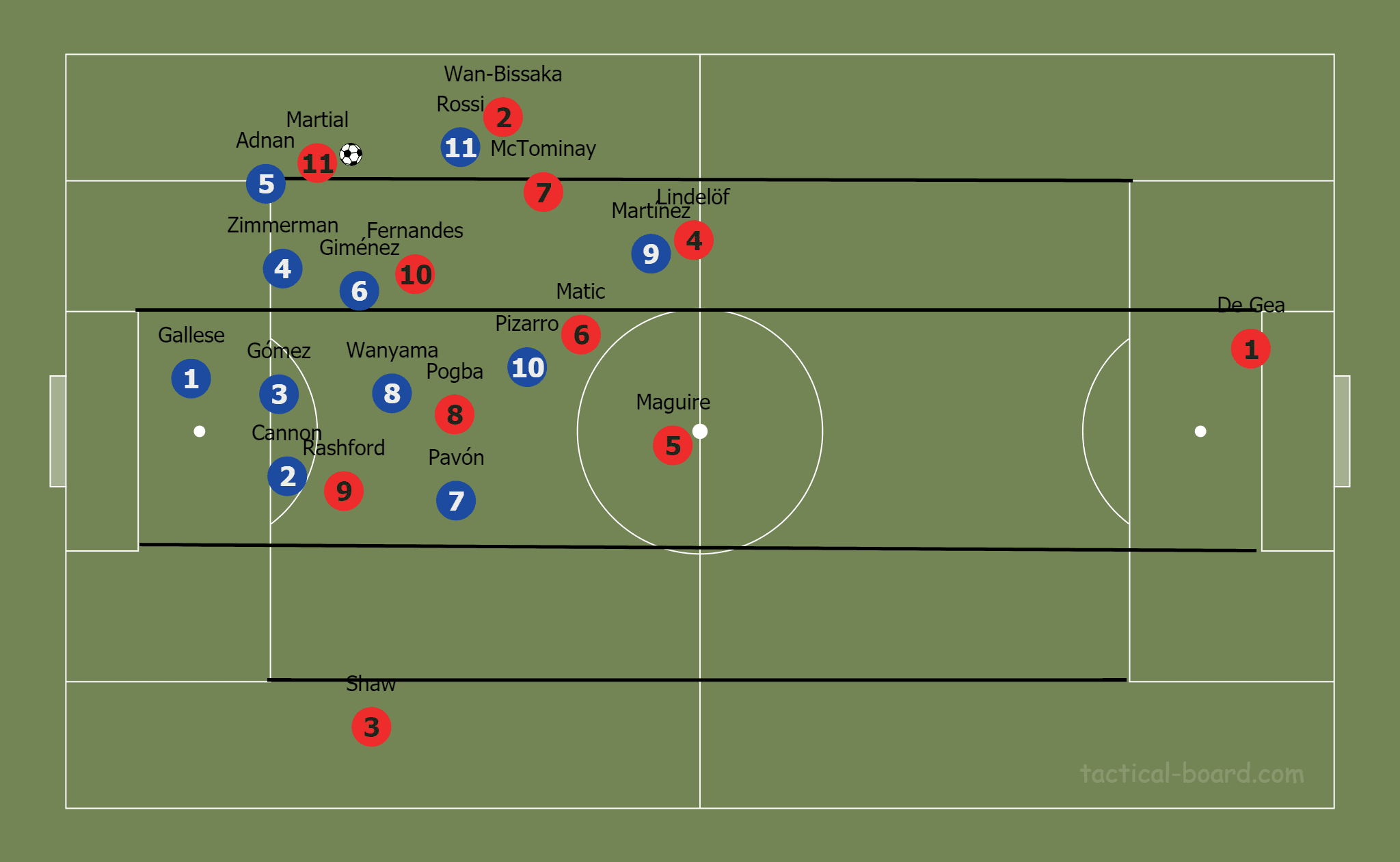
When United does get into the attacking third, we want them to create from the wide areas knowing that our backline will win any crosses into the box, especially if they’re played in the air. United tends to overload the wide areas and either cross or play the switch before crossing. Ideally, we’ll deny the switch of play here and win the ball or force the cross.
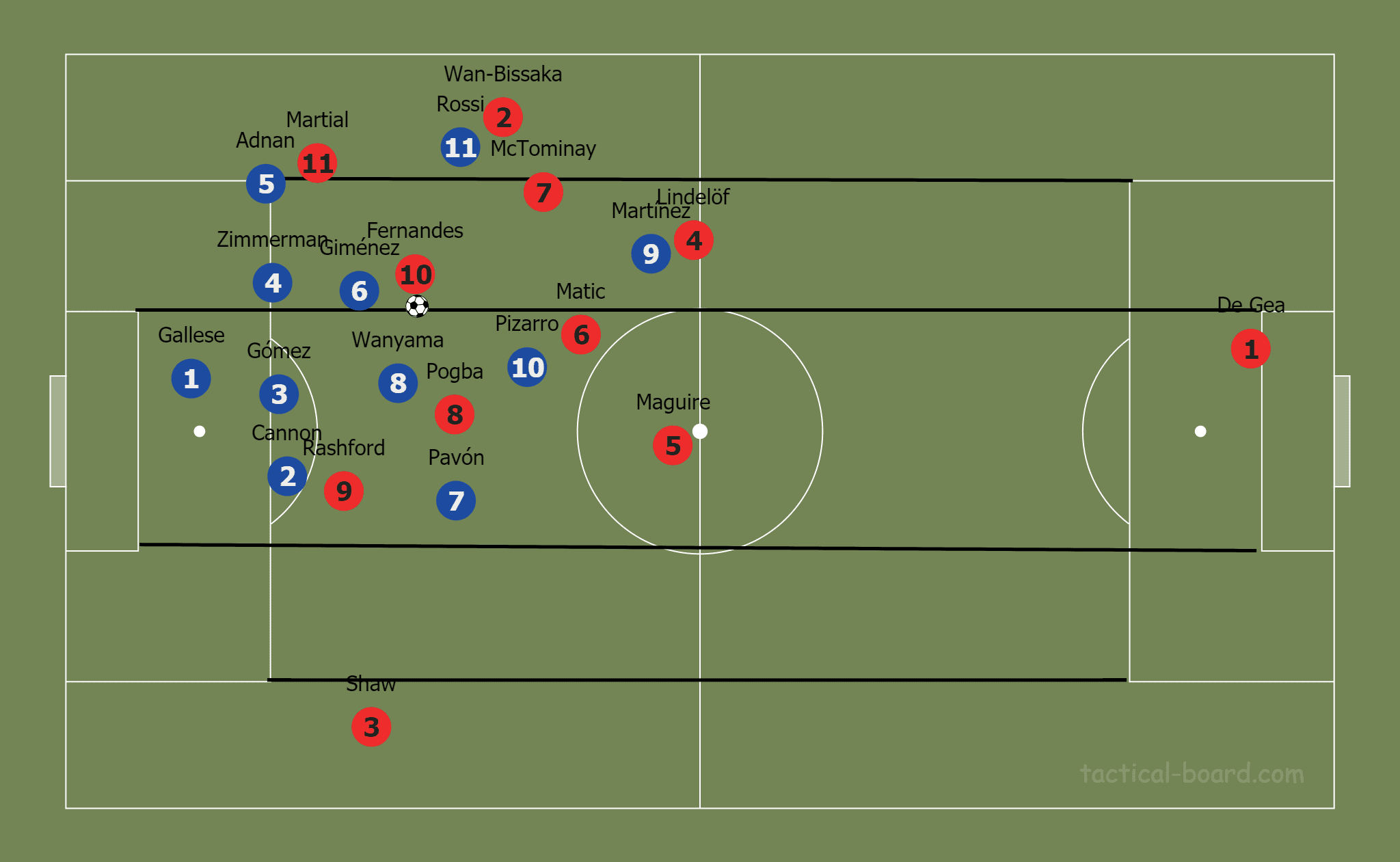
If they get the ball to Fernandes in the half space, we must respect his ability to score from distance, denying him time and a shooting lane. We want him to play backwards or back out wide, even if that means switching play.
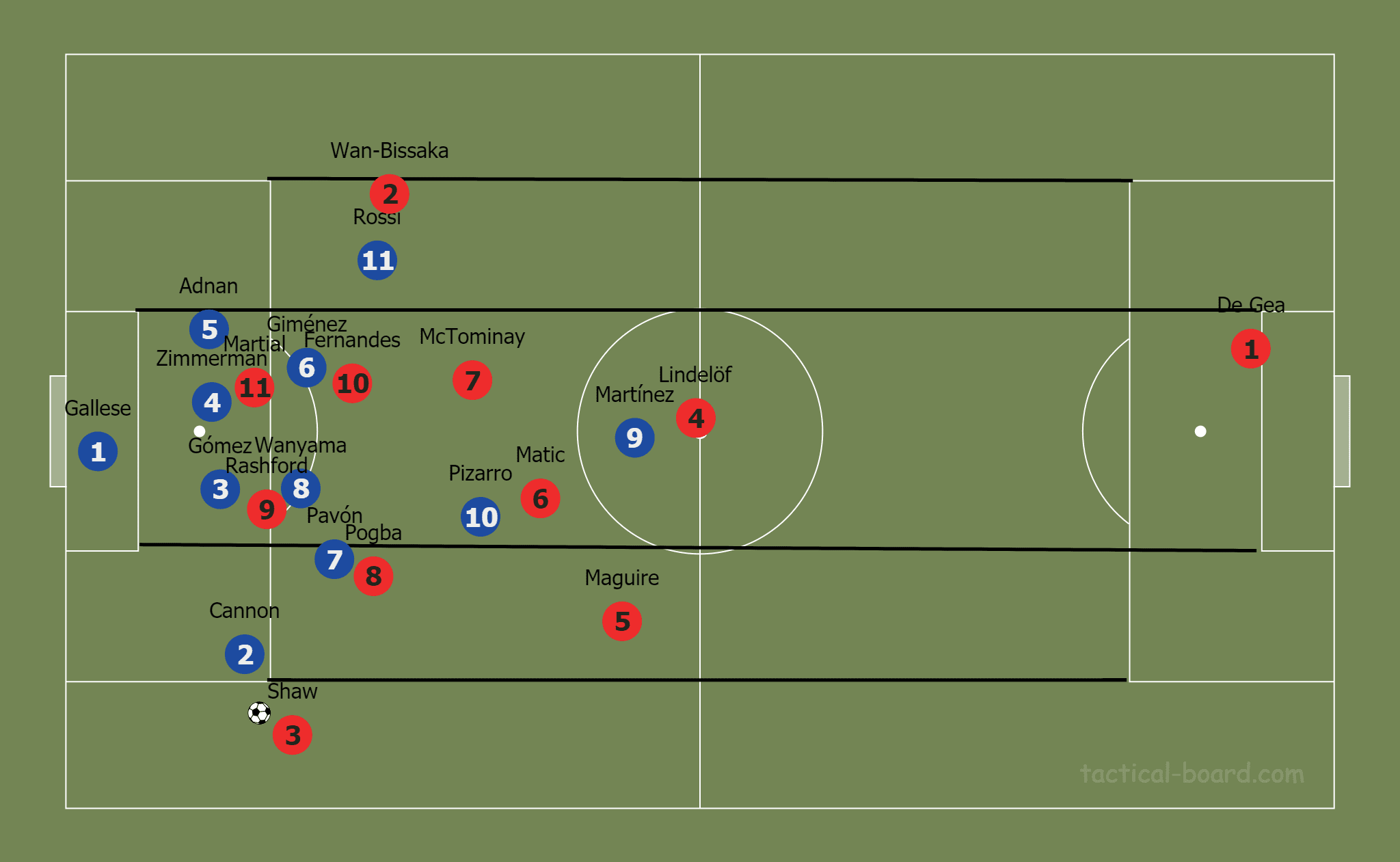
Assuming United switches play, our outside-backs must be prepared to hustle out to the wings to limit the quality of potential deliveries into the box. We won’t go in on the tackle, at least not initially, but we will look to contain the play and protect against penetration via 1v1 dribbling. Cannon and Adnan are great athletes who excel in 1v1 scenarios, so I trust them to contain the threats of Shaw and Wan-Bissaka. While we move out to contain the new threat, the rest of the backline and the two holding mids must track the runs into the box. We cannot turn off once the switch is completed because we know the ball is coming right back to those far-sided players.
Offensive transition
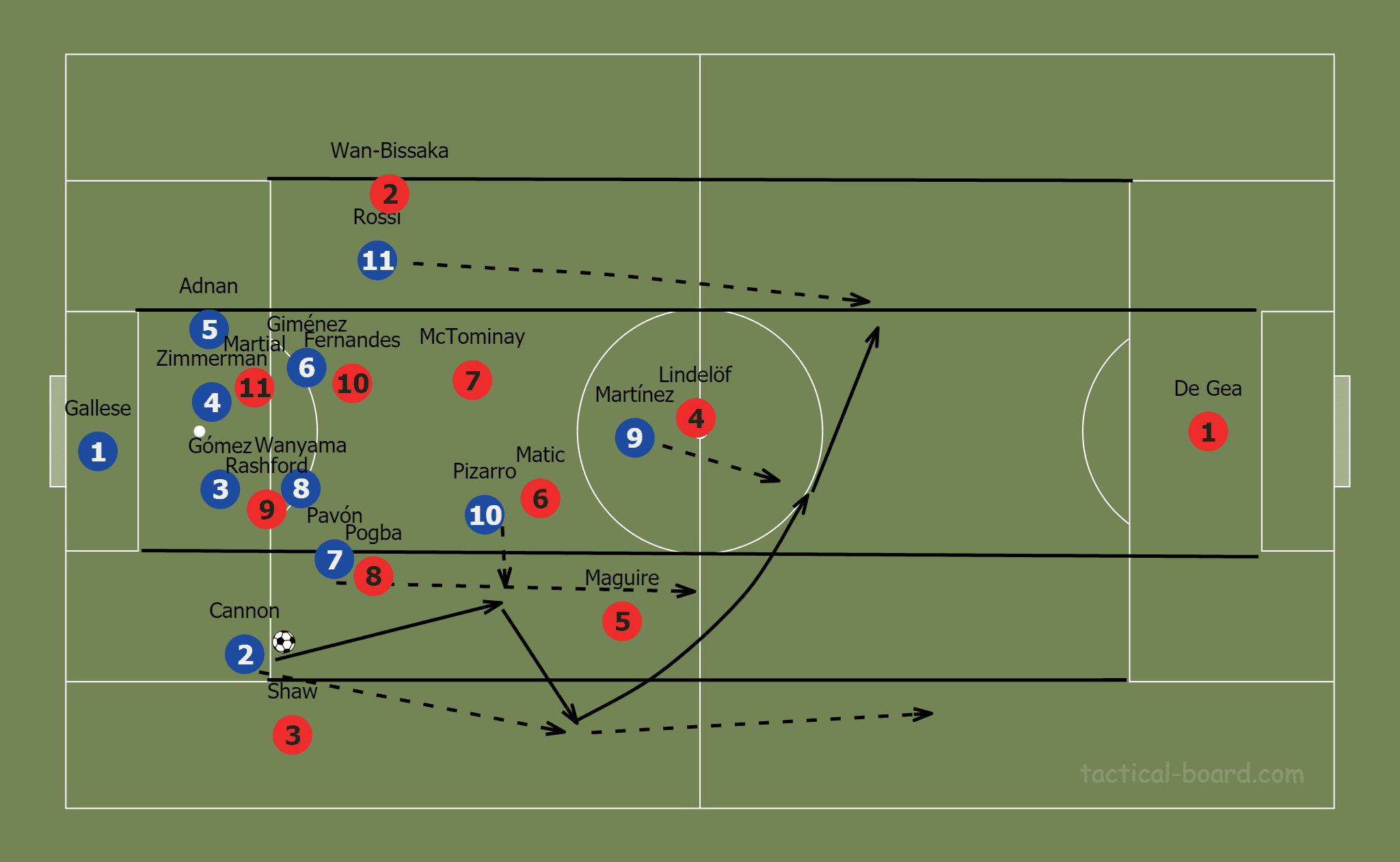
When we are able to win the ball in our defensive third, in this scenario with Cannon taking the ball off of Shaw, we’ll look for our high, central outlets right away. Pizarro must always defend with the thought that we’ll primarily look to play him. Once our we play to the high outlet, our wide attacking midfielders must race in front of Man U’s outside-backs. In this case, I also want Cannon releasing the pass and then getting behind Shaw to play a give and go off Pizarro, provided Pizarro is the clear winner of that initial pass. Once we return to Cannon, he has the option to dribble forward while pinning Maguire or he can look for the progressive runs of Martínez and the wide-attacking mids. If Maguire moves forward to engage Cannon, he should pass around the big Englishman. Given the pace we have up top, if we can run at their centre-backs and Matic, we hold an advantage and will need to capitalize on our opportunities.
Attacking play patterns
Though Manchester United has a team-wide qualitative advantage, I have some high-quality players too. My guys want to show the world that they’re ready for that big transfer across the pond, so I do want them to showcase their talents in the attack. We’ll look to use Man U’s aggressive high-press against them, inviting and clearing the first line of pressure to give my young squad the running room to burst into the pockets of space created by United’s press.
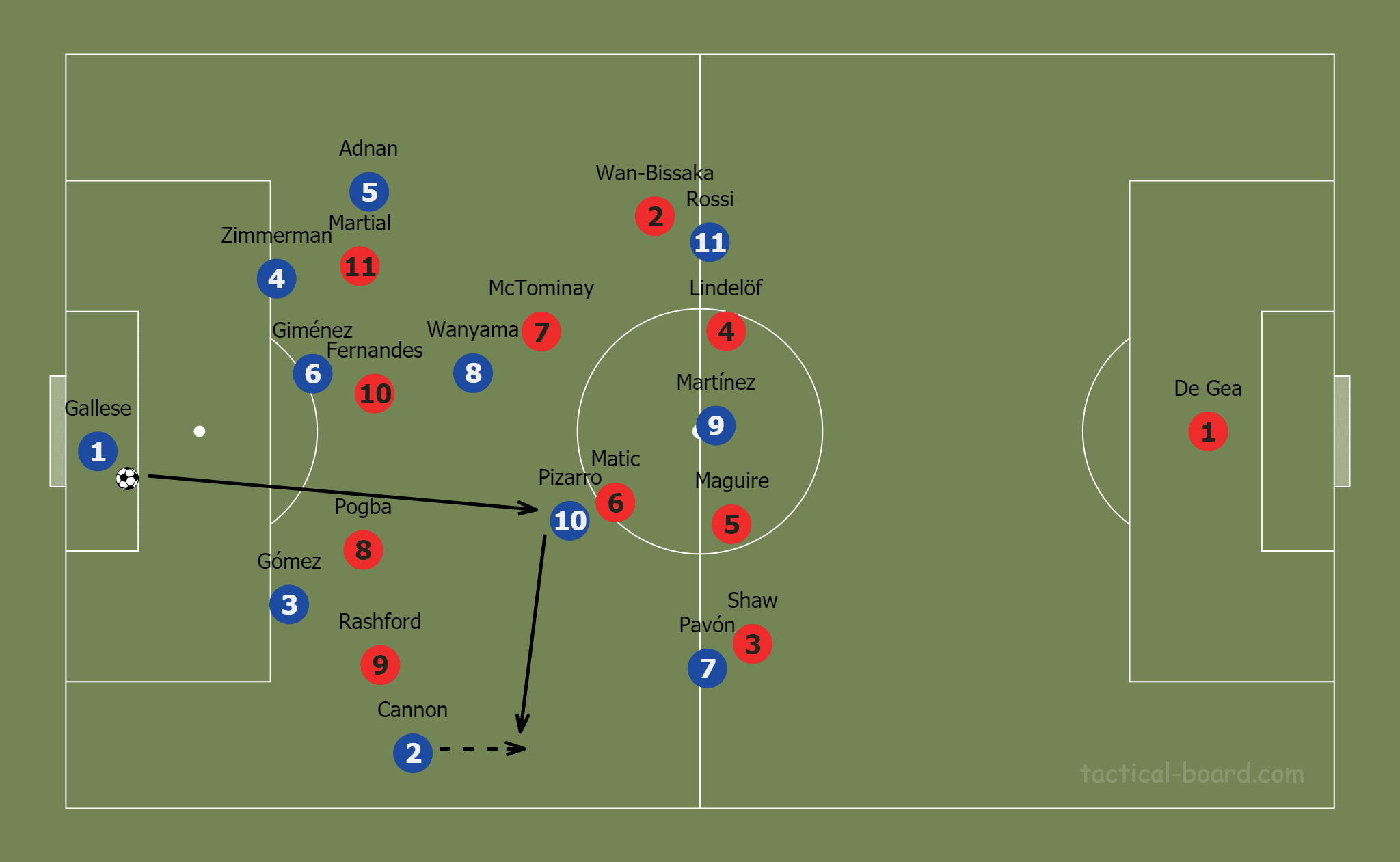
In this first build-out scenario, we can look to stretch the width of the field, having our first two lines take up shallow starting points to create a receiving lane for Pizarro. When we play him, he should release one of the two outside-backs immediately and allow them to take their space. I don’t see Pogba or Fernandes chasing us deep into United’s half, so Cannon and Adnan will have loads of running room on the wings and we will outnumber then in those areas.
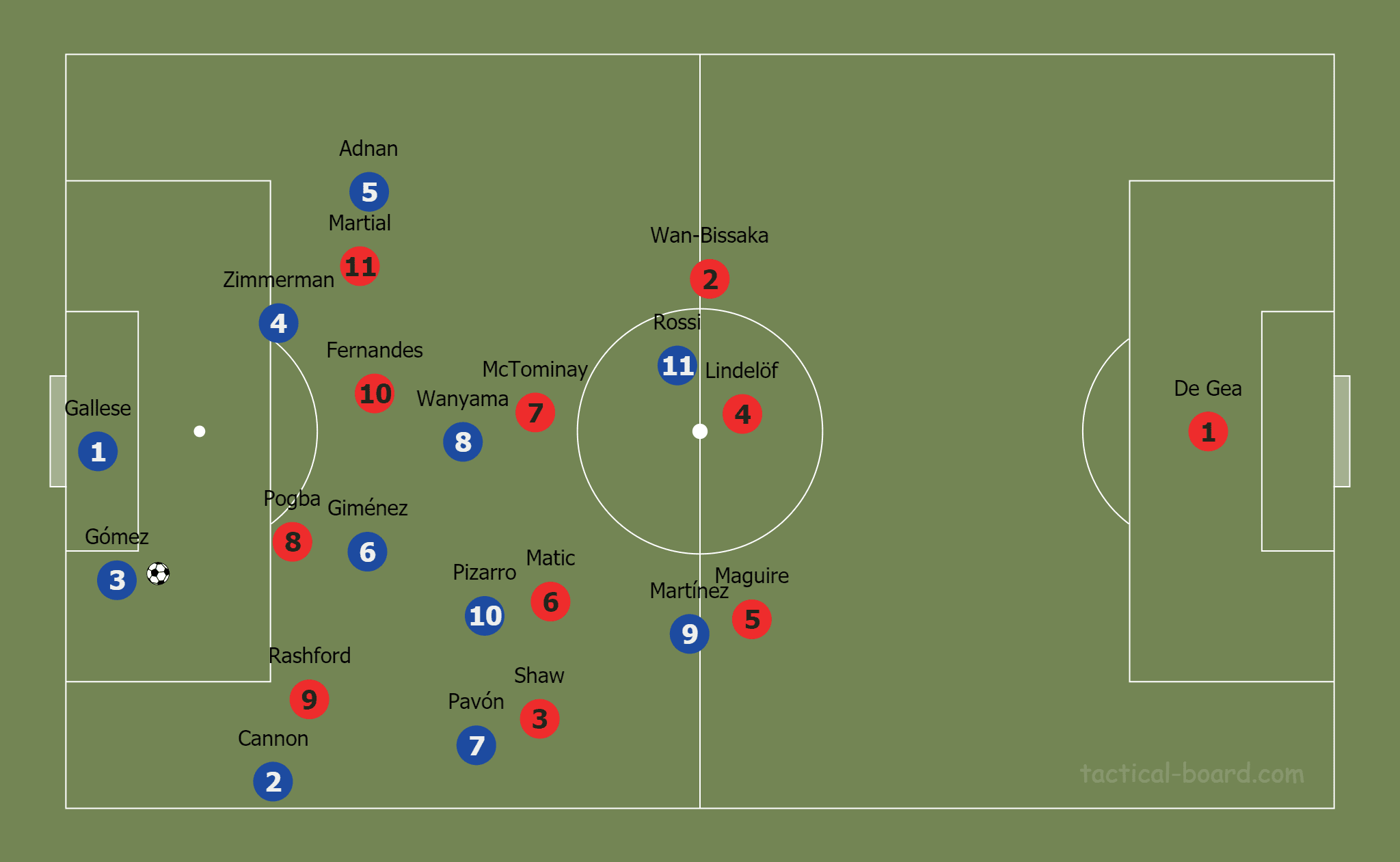
In a scenario where one of our centre-backs drops to receive from Gallese, we want to maintain a numerical superiority on that vertical half of the pitch while also having an eye to release our far-sided outside-back into the immense space on his side of the pitch.
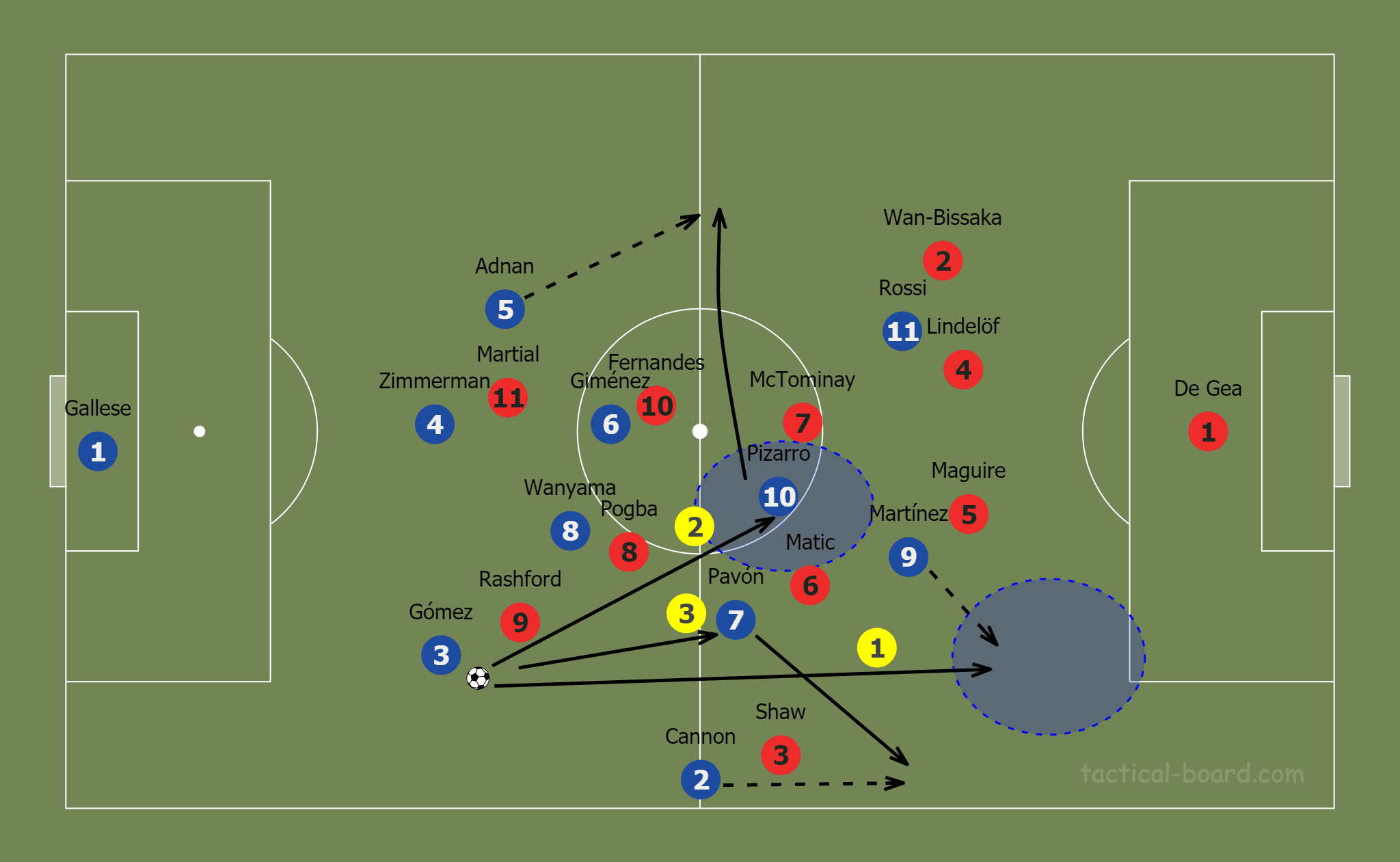
As we build into the middle third and prepare to attack United, we want to have a few sequences in mind. First, if a wide-attacking midfielder drops to help with the build-up, we can look to target Martínez in the space they’ve vacated, which also serves to disconnect the United centre-backs. Secondly, we can look for Pizarro, who, while having the freedom to read the play and create, will have the switch of play in mind. Third, if their near-sided outside-back pushes higher to mark our outside-back, we want our guy looking for opportunities to engage in third man runs behind him.
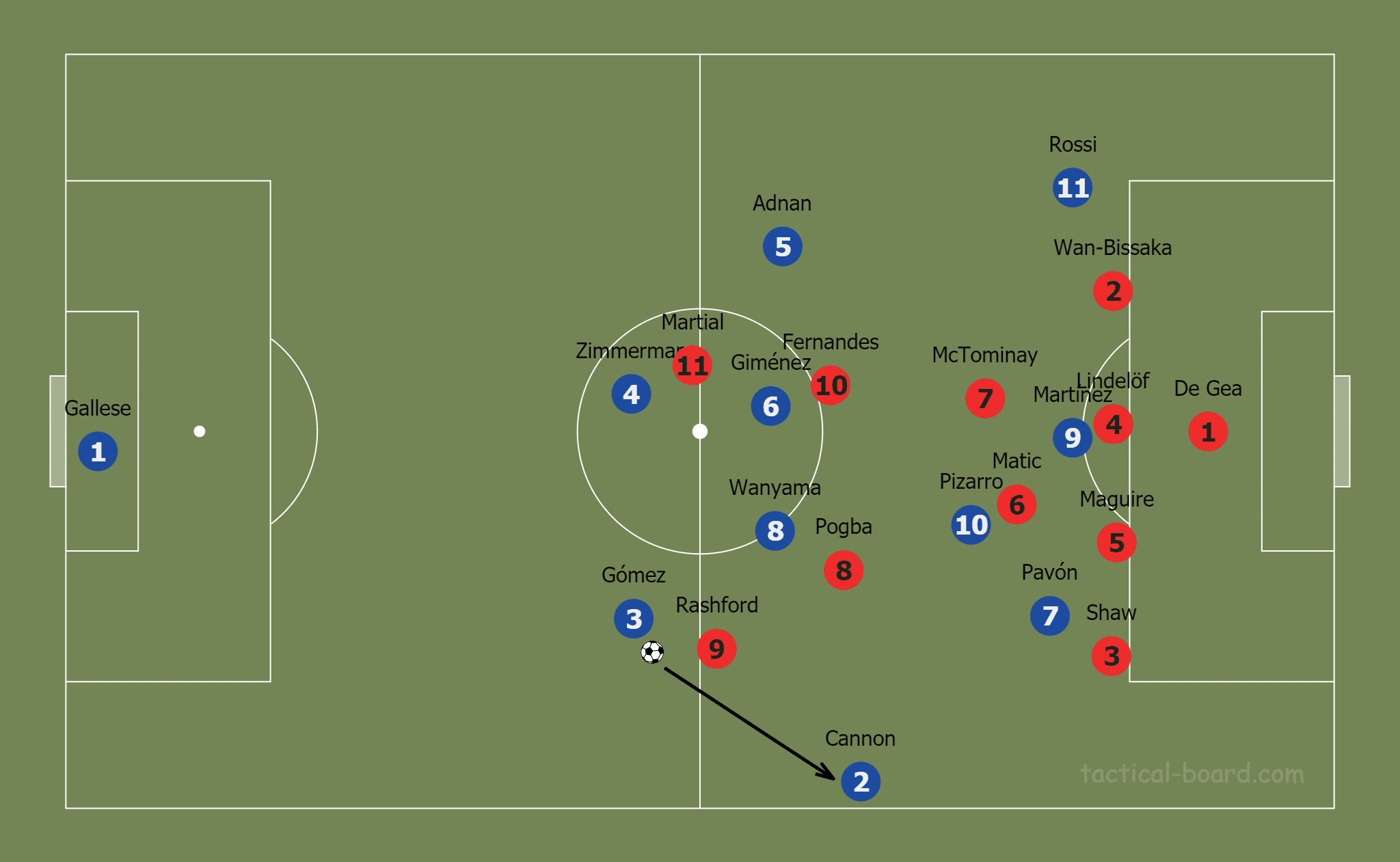
If their outside backs drop off to help with our wide-attacking mids, who move more centrally as we approach the United goal, we’ll play our outside-backs. Given the size advantage United have, the majority of our crosses would be early, allowing our quicker players to run in behind the centre-backs.
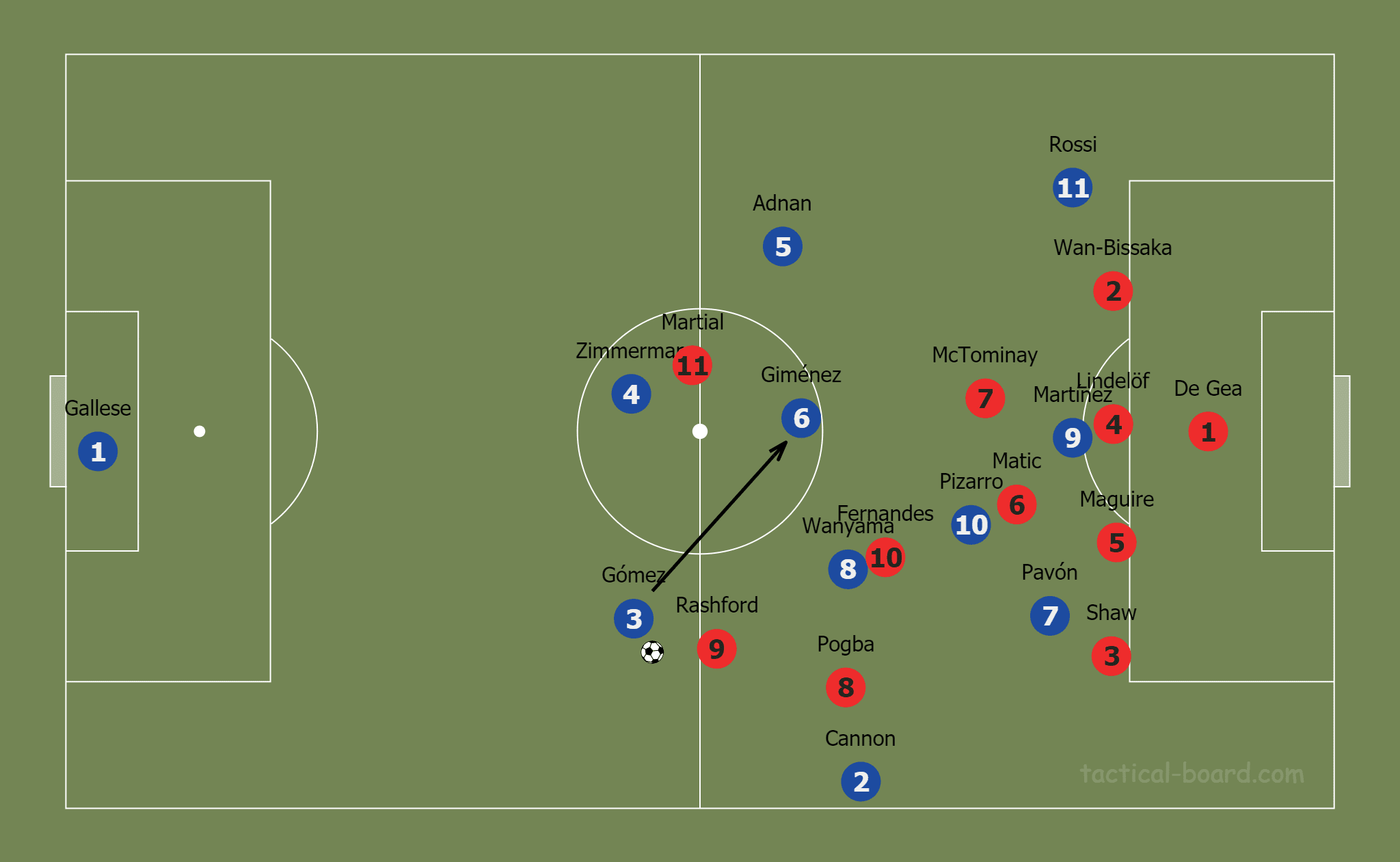
If the Pogba and McTominay are tasked with denying entry to our outside-backs, we’ll look for central penetration through our pivots.
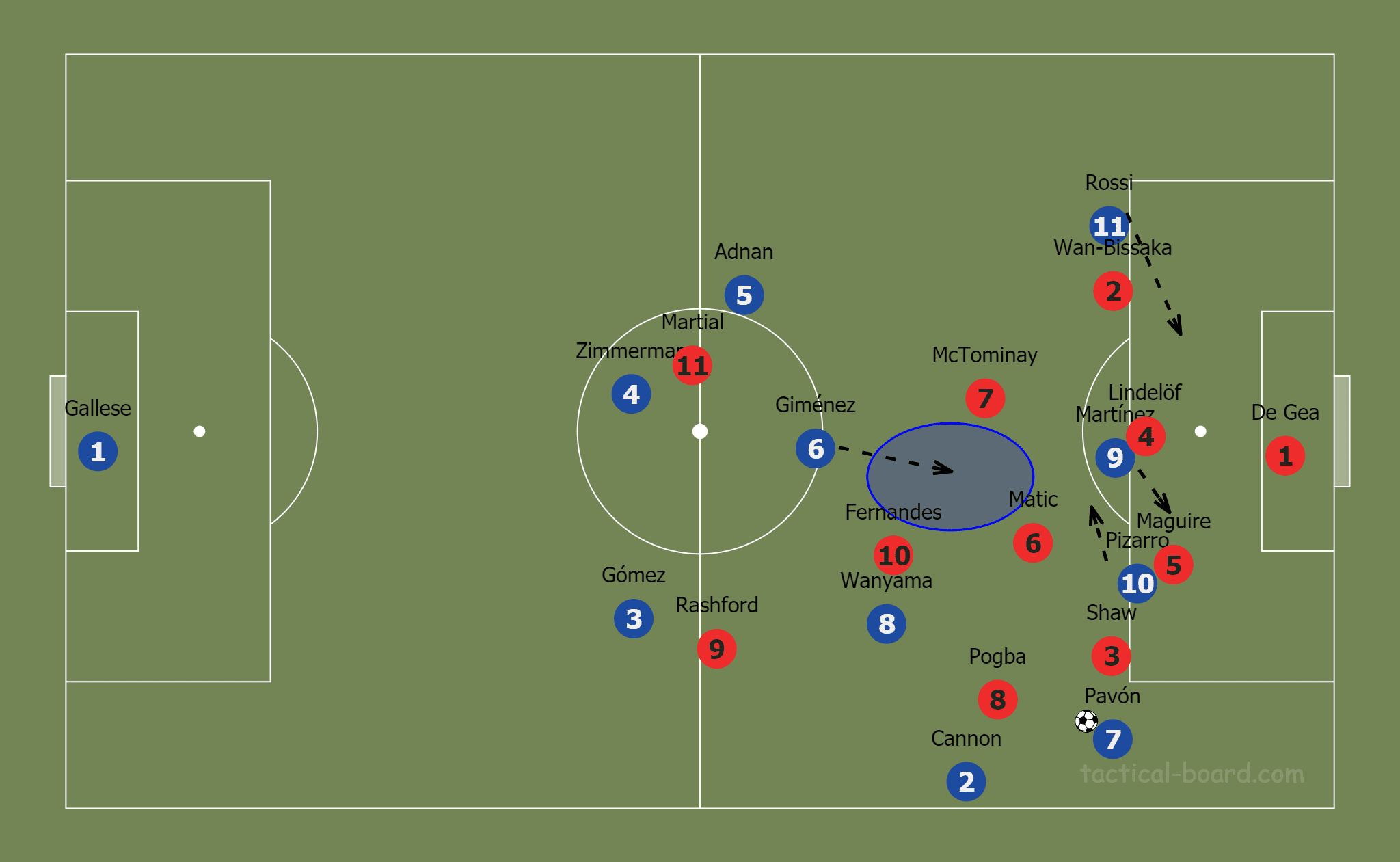
Finally, as we enter the attacking third and prepare our assault on goal, we can look to send passes centrally from the half spaces, find the darting runs of our goal-scoring attackers or look for our defensive mids to make runs from deep positions into the space in front of Matic and McTominay. Wanyama and Giménez can look to distribute from there knowing they have time to look for the killer pass. If it’s not on, we can complete the switch and try again.
Defensive transition
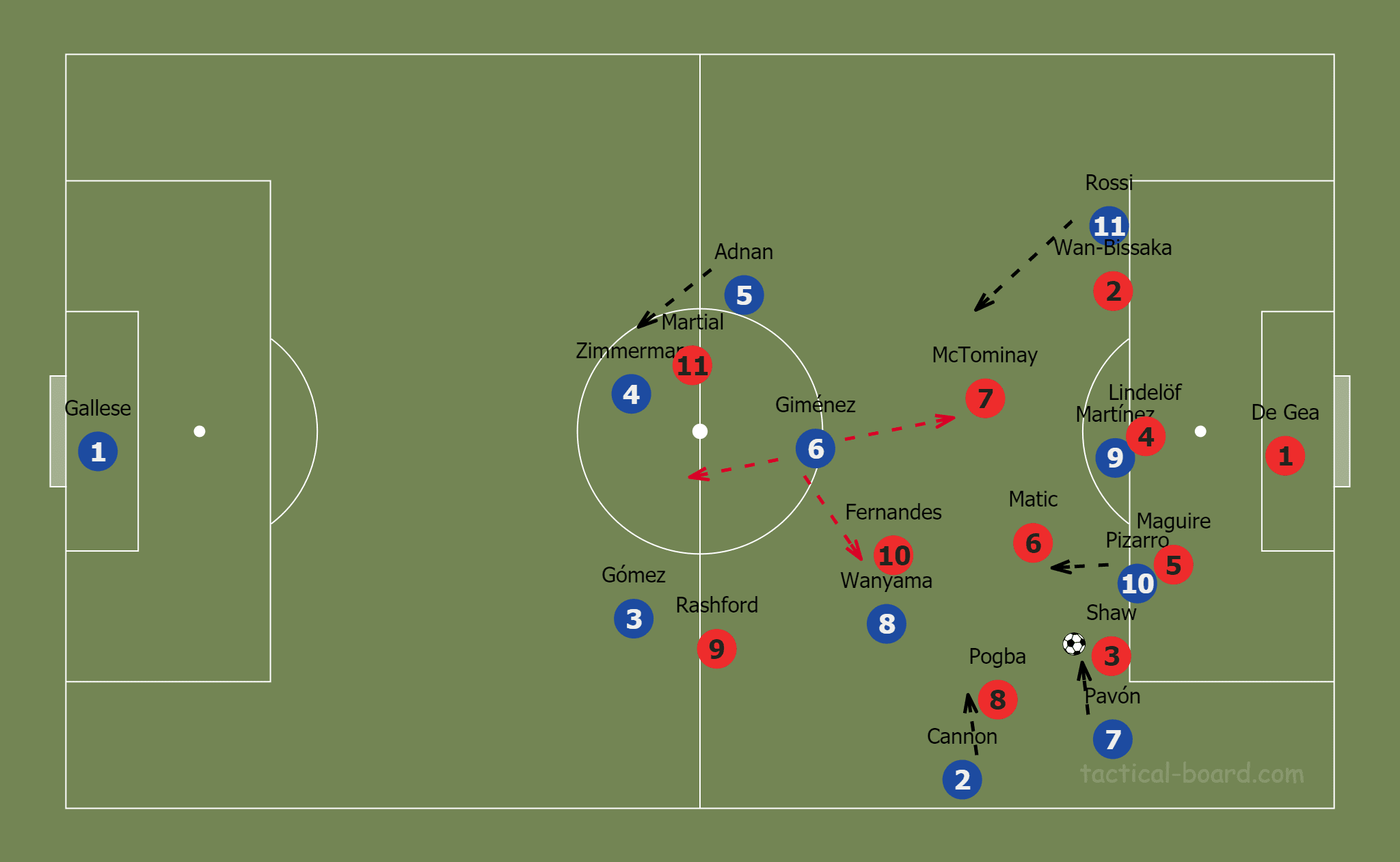
Once we lose the ball, we must counter-press quickly to deny entry to Fernandes and the forwards. It may be a friendly, but we’ll foul if we can’t slow their attack. Solskjær and I can share words after the match, maybe during (wouldn’t be the first time at an MLS All-Star game). We’re here to win, so we’ll do everything in our power to ensure the result goes our way.
Conclusion
While Manchester United will have a qualitative advantage, they’re in preseason mode and simply looking to regain fitness. The result won’t mean much to them, but it will for my young, hungry side. I’ve selected a side that sees this match as a stepping stone to the next phase of their career. European competition awaits my players, and it all starts here. MLS is a budding league with high-quality scouting and analysis departments. An influx in talent, including starters from South America’s national teams, positions MLS for massive growth. The league is well on its way to becoming a top developmental league. Rather than signing older stars, the league is clearly shifting focus from surviving to thriving off the backs of marquee young talent. European clubs are already viewing the USA as an emerging hub for young talent (see the Bundesliga). After we defeat United, Europe’s view of MLS will grow even further, prompting them to do their shopping in this league chalked full of young talent.





Comments